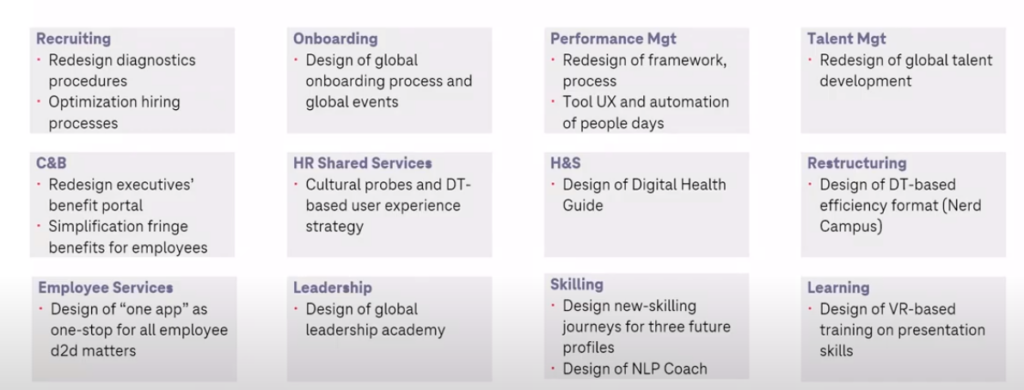About Deutsche Telekom
The Deutsche Telekom AG is Europes largest telecommunicationcompany by revenue. The headquarter of the company is in Bonn. Deutsche Telekom was formed in 1995. The company operates several subsidiaries worldwide, including the mobile communications brand T-Mobile. Furthermore it uses Design Thinking since 2010.
Design Thinking – in a nutshell (HR)

Over the last 9 Years Design Thinking helped the Deutsche Telekom HR Team to understand what is the real problem. Afterthat they simplify the process for the user and digitize it. Throughout the journey of redesigning the process and probing it the team constantly learns from solving upcoming problems. When the prototype-process works they try to scale and integrate it into the real system.
Design Thinking journey
In 2010 the Product Design team at Deutsche Telekom AG starts applying Design Thinking occasionally. Three years later in 2013 the new HR manager starts with a Design thinking based consulting. After the HR team improved a lot by using Design Thinking it expanded to CEO agenda in 2016. The HR team looked for ways to scale Design Thinking into more areas of the company. In 2017 Design Thinking became a module in the in-house academy. In 2018 the HR team had to use Design Thinking for every process from now on.
Transformation “philosophy”
To apply Design Thinking in HR the management team did not use a top-down approach. Whenever an HR Problem occurred and a new process had to be designed the management team would help out and show the workers why design thinking is the better method to design a process. So the philosophy of the HR management team is to give people the firsthand experience to work with Design Thinking and let them see for themself. That would change the mindset of the workers and it would be easier to implement it and change the culture of the organisation.

Example – Employee Personas
Deutsche Telekom HR invested time in trying to understand their employee base. It is a large project because they have more than 6000 job profile and more than 200 job families applicable for around 200000 people. The first step they did with the help of Design Thinking is they merged them into 21 Job personas. These personas are representing an archetype of an employee type. One of these personas is for example someone working in technical field force and it shows his journey throughout the day for example the use of digital tools and where is the lunchbreak. The personas shows what the employees need throughout a regular working day. The persona of the technical field force employee for example showed that Deutsche Telekom AG needs to invest more in high end smartphones for the technical field force. Now every employee working in that field got a high end smartphone because they need smartphones everyday to manage their own workflow.
Example – Digital Collaboration
Deutsche Telekom HR also does regular Design Thinking workshops with 500 hundred employees for example to create a new user interface for their sharepoint webside. This is the result from the workshop:

Design Thinking in todays HR skills ecosystem
The Human Resource Team of Deutsche Telekom AG has a lot of experience with Design Thinking. After years of testing out they came up with a final implementation of their Design Thinking process. It is just slightly different than shown in the beginning of this blog: “Understand the problem” -> “Iterate solutions” -> “Testing” -> “Implementation” -> “Digital Scaling”. But very important is that the HR Team did use pure Design Thinking in the first years but it did not quiet work out.
For the Deutsche Telekom it Design Thinking only works with support from other methods. In the implementation phase they use scrum master and agile coaches to support Design Thinking. The Implementation is planned with Objectives and Key Results (OKR) for example. The whole ecosystem consists of various skills:
1 Method skill
- Agile & OKRs
- UX & Innovation (Design Thinking)
- Systems Thinking
- Systemic Coaching
2 Technology skills
- People Tech
- Cloudification/SW-ization
- People Analytics
- Digitization
3 Transformation skills
- Journey design
- Experience design
- Communication & Community Mgt
- Product marketing
4 Leadership skills
- Growth mindset
- Outcome orientation
- Servant leadership
Conclusion
Key learnings of this case study on how to implement Design Thinking should be that you should start small. Just try Design Thinking in one small project. If that worked well you can go to the next step and do more projects with the Design Thinking approach. The second thing is that it is not all about the method do not try to force the design thinking cycle onto people, it is fine to create your own Design Thinking process. It is more about collaboration and customer or in this case employee orientation.


